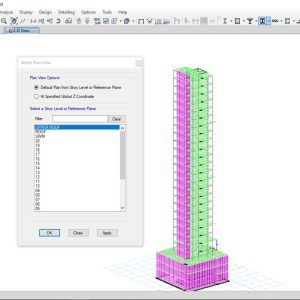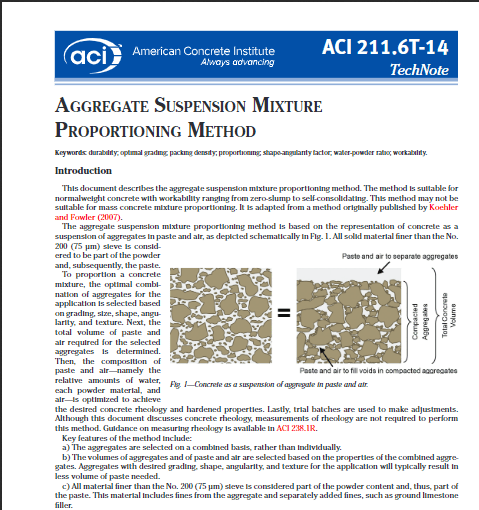Description
-
 MS Office Professional Essential Training$200.00
MS Office Professional Essential Training$200.00 -
 Primavera P6 Professional Training Course$250.00
Primavera P6 Professional Training Course$250.00 -
Product on sale
 20+ Story High Rise BuildingOriginal price was: $39.99.$9.99Current price is: $9.99.
20+ Story High Rise BuildingOriginal price was: $39.99.$9.99Current price is: $9.99. -
 CSI SAFE Essential Training Course$250.00
CSI SAFE Essential Training Course$250.00 -
 CSI ETABS Essential Training Course$350.00
CSI ETABS Essential Training Course$350.00
This document describes the aggregate suspension mixture proportioning method. The method is suitable for normalweight concrete with workability ranging from zero-slump to self-consolidating. This method may not be suitable for mass concrete mixture proportioning. It is adapted from a method originally published by Koehler and Fowler (2007).
The aggregate suspension mixture proportioning method is based on the representation of concrete as a suspension of aggregates in paste and air, as depicted schematically in Fig. 1. All solid material finer than the No. 200 (75 μm) sieve is consid-ered to be part of the powder and, subsequently, the paste.To proportion a concrete mixture, the optimal combi-nation of aggregates for the application is selected based on grading, size, shape, angu-larity, and texture.
Next, the total volume of paste and air required for the selected aggregates is determined. Then, the composition of paste and air—namely the relative amounts of water, each powder material, and air—is optimized to achieve the desired concrete rheology and hardened properties. Lastly, trial batches are used to make adjustments. Although this document discusses concrete rheology, measurements of rheology are not required to perform this method. Guidance on measuring rheology is available in ACI 238.1R.Key features of the method include:a)
The aggregates are selected on a combined basis, rather than individually.b) The volumes of aggregates and of paste and air are selected based on the properties of the combined aggre-gates. Aggregates with desired grading, shape, angularity, and texture for the application will typically result in less volume of paste needed.c) All material finer than the No. 200 (75 μm) sieve is considered part of the powder content and, thus, part of the paste. This material includes fines from the aggregate and separately added fines, such as ground limestone filler.d)
The water-powder ratio (w/p) is considered when adjusting workability and the water-cementitious mate-rials ratio (w/cm) is considered when aiming to achieve desired hardened properties. The difference between w/p and w/cm is attributable to noncementitious fines such as ground limestone filler and other mineral fillers.Calculations should be performed in a computer application. Use of this method results in proportions based on aggregates in saturated surface-dry (SSD) condition.
The user should make corrections for aggregate mois-ture content when making trial or production batches.Use of this proportioning method may result in otherwise acceptable but different proportions than those determined in ACI 211.1.Keywords: durability; optimal grading; packing density; proportioning; shape-angularity factor; water-powder ratio; workability.Fig. 1—Concrete as a suspension of aggregate in paste and air.ACI 211.6T-14TechNote
-
 Turnitin Instructor with AI Detection$70.00 – $130.00
Turnitin Instructor with AI Detection$70.00 – $130.00 -
 SmartPLS 4.1 Processional | Lifetime activation key$60.00
SmartPLS 4.1 Processional | Lifetime activation key$60.00 -
 EndNote Lifetime for Windows /Mac Software Full Version$8.00 – $15.00
EndNote Lifetime for Windows /Mac Software Full Version$8.00 – $15.00 -
![Aggregate Suspension Mixture proportioning Method 11 IBM SPSS Statistics v30 | v29 [Lifetime Activation with key]](https://civilmdc.com/wp-content/uploads/2022/03/IBM-SPSS-30-Key-300x300.jpg) IBM SPSS Statistics v30 | v29 [Lifetime Activation with key]$15.00 – $45.00
IBM SPSS Statistics v30 | v29 [Lifetime Activation with key]$15.00 – $45.00 -
 LinkedIn ALL COURSES LIFETIME Warranty$25.00
LinkedIn ALL COURSES LIFETIME Warranty$25.00 -
Product on sale
 REF-N-WRITE | Premium Account Lifetime ActivationOriginal price was: $45.00.$22.00Current price is: $22.00.
REF-N-WRITE | Premium Account Lifetime ActivationOriginal price was: $45.00.$22.00Current price is: $22.00. -
 QuillBot’s paraphrasing tool | Premium Account 6 month | + WARRANTY$12.00
QuillBot’s paraphrasing tool | Premium Account 6 month | + WARRANTY$12.00 -
 Grammarly Premium Account 6 Month |12 month$20.00 – $35.00
Grammarly Premium Account 6 Month |12 month$20.00 – $35.00 -
 TURNIT1N Student (Plagiarism Checker) – 6 Month | 1 Year | 2 Years | 3 Years | 4 Years | LifeTime$15.00 – $200.00
TURNIT1N Student (Plagiarism Checker) – 6 Month | 1 Year | 2 Years | 3 Years | 4 Years | LifeTime$15.00 – $200.00



 Visit
Visit 